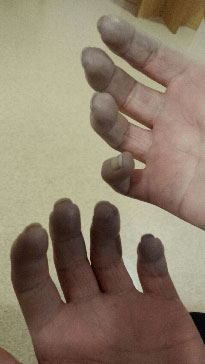_ RCGP Learning
Blog entry by _ RCGP Learning
 This February is “Raynaud’s Awareness Month”. This common dermatological phenomenon was named after Maurice Raynaud, who in 1862 described the condition afflicting a 26 year old female patient. Although epidemiology varies depending on local weather, work exposure and sex, most population-based surveys estimate its prevalence between 3 to 5%. Patients can be divided into two different groups: those with primary Raynaud’s phenomenon, which is diagnosed when no underlying disease is found; and those with secondary Raynaud’s phenomenon, which is diagnosed when there is an associated disease. The differentiation between the two of them is of importance, as secondary Raynaud’s has the potential for serious complications. Its associated diagnoses -systemic sclerosis, vasculitis, systemic lupus erythematosus, rheumatoid arthritis, peripheral vascular disease - are potentially serious and can cause deterioration in quality of life. As 30 to 50% of patients with primary Raynaud’s have a first degree relative condition, a genetic component is likely1.
This February is “Raynaud’s Awareness Month”. This common dermatological phenomenon was named after Maurice Raynaud, who in 1862 described the condition afflicting a 26 year old female patient. Although epidemiology varies depending on local weather, work exposure and sex, most population-based surveys estimate its prevalence between 3 to 5%. Patients can be divided into two different groups: those with primary Raynaud’s phenomenon, which is diagnosed when no underlying disease is found; and those with secondary Raynaud’s phenomenon, which is diagnosed when there is an associated disease. The differentiation between the two of them is of importance, as secondary Raynaud’s has the potential for serious complications. Its associated diagnoses -systemic sclerosis, vasculitis, systemic lupus erythematosus, rheumatoid arthritis, peripheral vascular disease - are potentially serious and can cause deterioration in quality of life. As 30 to 50% of patients with primary Raynaud’s have a first degree relative condition, a genetic component is likely1.
Patients describe well demarcated, episodic blanching of one or more fingers (or toes, ears, nipples and ears) caused by peripheral vasospasm and triggered by a cold environment or emotional stress. This can be followed by a blueish, cyanotic colour (in a third of all patients), before the fingers turn bright red during a period of reperfusion, associated with stinging and throbbing. The symptoms can last for minutes and up to several hours.
 Raynaud’s phenomenon isn’t the only diagnosis that can cause vascular symptoms in the periphery: exposure to the cold can cause physiological pallor, an acute cholesterol embolism can mimic the discolouration of Raynaud’s phenomenon (though doesn’t have its episodic nature) and thrombangitis obliterans (recurrent thrombosis of small/medium arteries and veins) can cause similar distal extremity ischaemia2.
Raynaud’s phenomenon isn’t the only diagnosis that can cause vascular symptoms in the periphery: exposure to the cold can cause physiological pallor, an acute cholesterol embolism can mimic the discolouration of Raynaud’s phenomenon (though doesn’t have its episodic nature) and thrombangitis obliterans (recurrent thrombosis of small/medium arteries and veins) can cause similar distal extremity ischaemia2.
Patients who present with primary Raynaud’s are usually younger (between 15 and 30 years of age), don’t appear to have symptoms affecting their thumbs and lack ulceration, digital pitting or gangrene. Patients presenting in general practice should be asked about the frequency and severity of the attacks, smoking and family history and for symptoms associated with the diagnoses underlying secondary Raynaud’s.
Examination should involve checks for peripheral vascular disease, blood pressure measurements and evidence of complications of secondary Raynaud’s. Examination of the capillaries of the nailbeds of the fingers can be attempted with an otoscope, ophthalmoscope or a dermatoscope, as dilated and distorted capillaries can point to underlying connective tissue disease3. Investigations should include FBC, ESR, ANA, U&Es, and urinalysis.
If examination and investigation points to primary Raynaud’s, pharmacological treatments are often not necessary, and lifestyle advice should be considered first: keeping warm, smoking cessation, avoiding exposure to cold weather. If non-pharmacological treatments in primary Raynaud’s are ineffective, calcium channel blockers such as nifedipine and nicardipine can be effective in reducing the frequency of attacks.
If treatment is ineffective or if there is suspicion of connective tissue disease or another underlying condition, the patient should be referred to the local rheumatology team4.
Images used with permission from the charity ‘Scleroderma & Raynaud’s UK’. Their website has extensive guidance for patients with Raynaud’s.
1 Fredrick M. Wigley and Nicholas A. Flavahan: Raynaud’s Phenomenon. August 11, 2016. N Engl J Med 2016; 375:556-565
2 Drerup, C; Ehrchen, J:Raynaud’s phenomenon. Practical management for dermatologists. Hautarzt 2019 · 70:131–141
3 Herrick, AL: Evidence-based management of Raynaud’s phenomenon. Ther Adv Musculoskel Dis, 2017, Vol. 9(12) 317–329
4 Pope, J: Raynaud’s phenomenon. BMJ Best practice. 2019. https://bestpractice.bmj.com/topics/en-gb/193